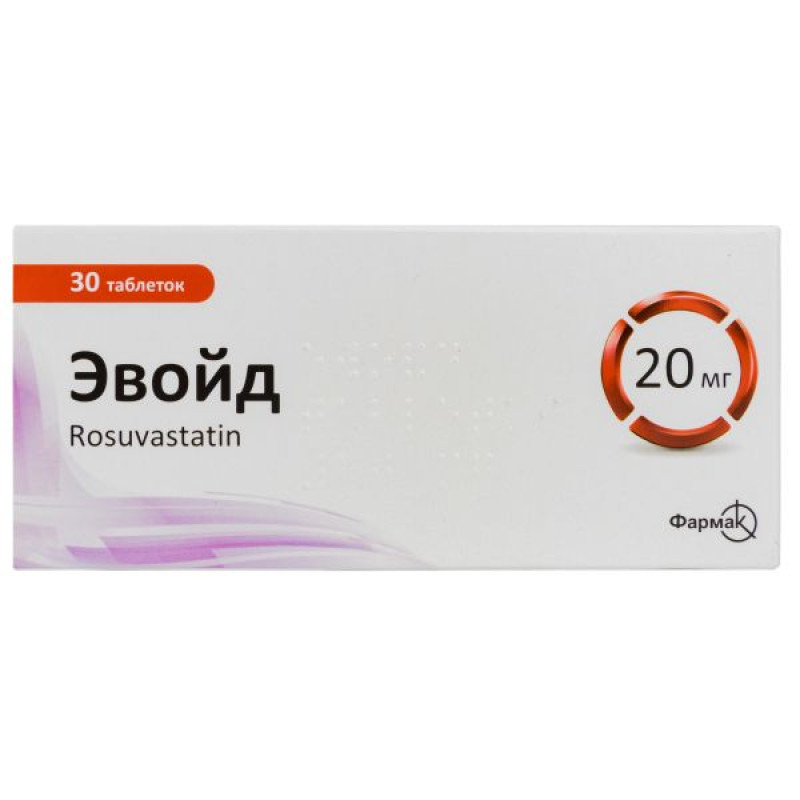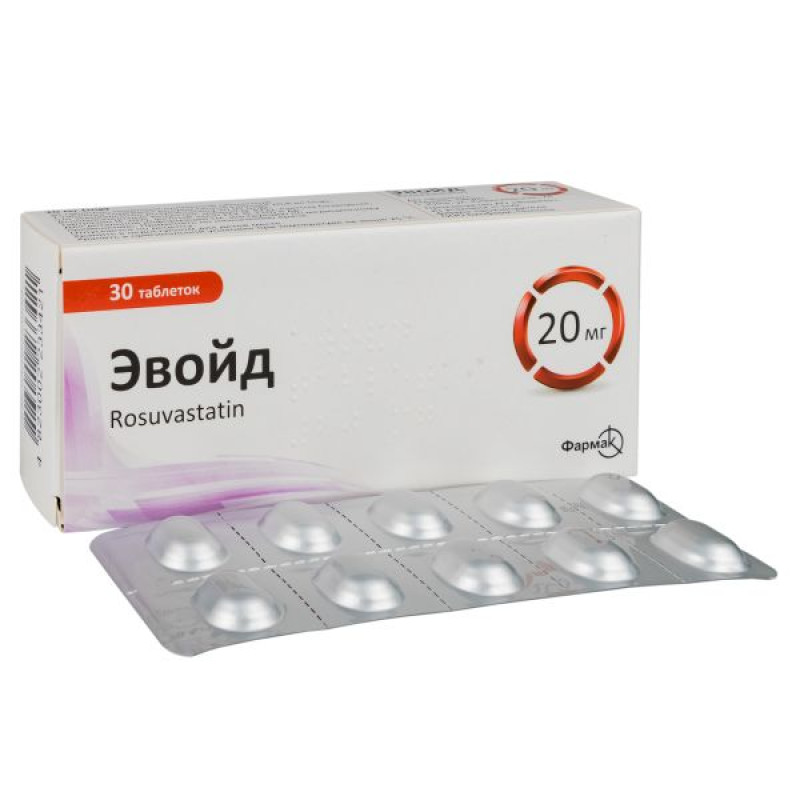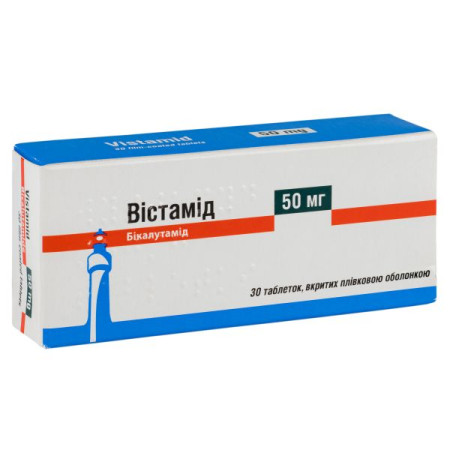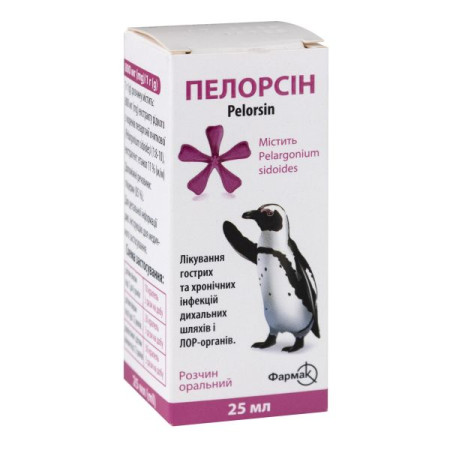Evoid film-coated tablets 20 mg blister No. 30
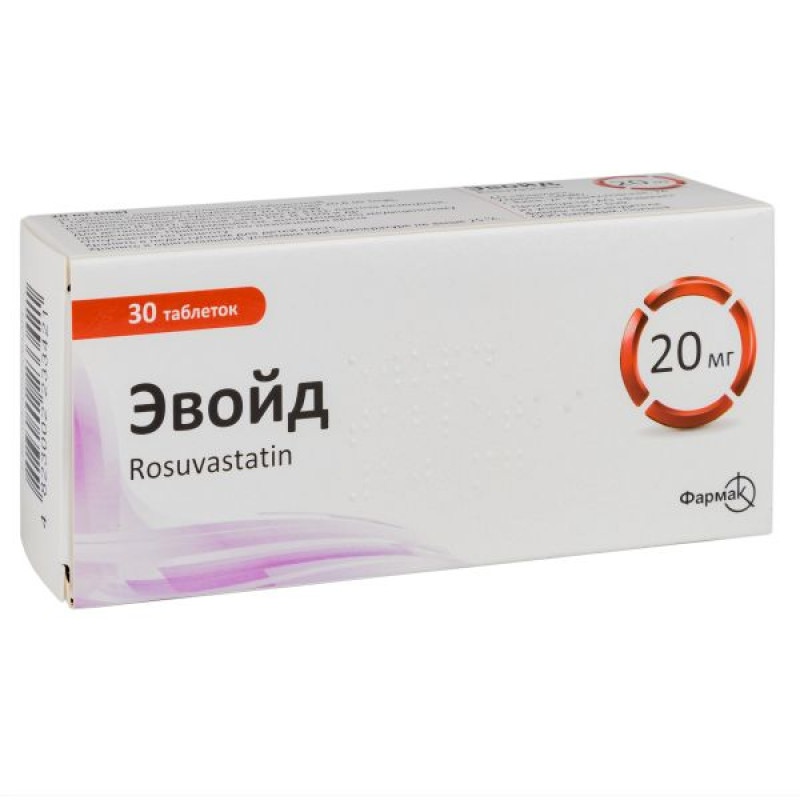
Instructions for use: Evoid film-coated tablets 20 mg, blister pack No. 30
Composition
active ingredient: rosuvastatin;
1 tablet contains rosuvastatin calcium 5.2 mg, 10.4 mg, 20.8 mg or 41.6 mg, which is equivalent to rosuvastatin 5 mg, 10 mg, 20 mg or 40 mg;
excipients: calcium citrate, microcrystalline cellulose, hydroxypropylcellulose, mannitol (E 421), lactose, crospovidone, magnesium stearate;
film coating (5 mg tablets): polyvinyl alcohol, titanium dioxide (E 171), macrogol 3350, talc, tartrazine (E 102), sunset yellow FCF (E 110), indigo carmine (E 132);
film coating (10 mg, 20 mg, 40 mg tablets): polyvinyl alcohol, titanium dioxide (E 171), macrogol 3350, talc, tartrazine (E 102), special red AC (E 129), sunset yellow FCF (E 110), indigo carmine (E 132).
Dosage form
Film-coated tablets.
Main physicochemical properties:
5 mg tablets: round tablets with a biconvex surface, film-coated, yellow in color;
10 mg tablets: round tablets with a biconvex surface, film-coated, pink in color;
20 mg tablets: oval-shaped tablets with a biconvex surface, with a score on one side, film-coated, pink in color;
40 mg tablets: oblong tablets with a biconvex surface, with a score on one side, film-coated, pink in color.
Pharmacotherapeutic group
Lipid-lowering agents. HMG-CoA reductase inhibitors.
ATX code C10A A07.
Pharmacological properties
Pharmacodynamics.
Mechanism of action
Rosuvastatin is a selective and competitive inhibitor of HMG-CoA reductase, the rate-limiting enzyme that converts 3-hydroxy-3-methylglutaryl coenzyme A to mevalonate, a precursor of cholesterol. The primary site of action of rosuvastatin is the liver, a target organ for lowering cholesterol levels.
Rosuvastatin increases the number of LDL receptors on the surface of liver cells, enhancing the uptake and catabolism of LDL, and inhibits hepatic synthesis of VLDL, thus reducing the total number of VLDL and LDL particles.
Pharmacodynamic action
Rosuvastatin reduces elevated LDL-C, total cholesterol, and triglycerides and increases HDL-C. It also reduces apoB, non-HDL-C, VLDL-C, TG-VLDL, and increases apoA-I (Table 1). Evoyd® also reduces the LDL-C/HDL-C, total-C/HDL-C, non-HDL-C/HDL-C, and apoB/apoA-I ratios.
Table 1
Dose response in patients with primary hypercholesterolemia types IIa and IIb
(adjusted mean percentage change from baseline)
| Dose | N | LDL-C | Total cholesterol | HDL-C | TG | Non-HDL-C | apoV | apoA-I |
| Placebo | 13 | 7 | -5 | 3 | 3 | -7 | 3 | 0 |
| 5 | 17 | 45 | 33 | 13 | 35 | 44 | 38 | 4 |
| 10 | 17 | 52 | 36 | 14 | 10 | 48 | 42 | 4 |
| 20 | 17 | 55 | 40 | 8 | 23 | 51 | 46 | 5 |
| 40 | 18 | 63 | 46 | 10 | 28 | 60 | 54 | 0 |
The therapeutic effect is achieved within 1 week after the start of the drug, 90% of the maximum effect is achieved after 2 weeks. The maximum effect is usually achieved after 4 weeks and continues thereafter.
Clinical efficacy and safety
Rosuvastatin is effective in the treatment of adults with hypercholesterolemia - with or without hypertriglyceridemia - regardless of race, sex, or age, as well as patients in special groups such as diabetics or patients with familial hypercholesterolemia.
According to pooled data, rosuvastatin effectively lowers cholesterol levels in most patients with type IIa and IIb hypercholesterolemia (mean baseline LDL-C level approximately 4.8 mmol/L) to the target values established by the recognized guidelines of the European Atherosclerosis Society (EAS; 1998); approximately 80% of patients taking rosuvastatin at a dose of 10 mg achieve the normative target levels of LDL-C according to the EAS (<3 mmol/L).
The beneficial effect of rosuvastatin in patients with heterozygous familial hypercholesterolemia on lipid parameters and achievement of target levels is noted at doses from 20 to 80 mg. After titration to a daily dose of 40 mg (12 weeks of treatment), LDL-C is reduced by 53%. In 33% of patients, normative LDL-C levels according to EAS (<3 mmol/L) were achieved.
In the general population of patients with homozygous familial hypercholesterolemia, taking rosuvastatin at doses of 20–40 mg reduces LDL-C levels by an average of 22%.
In a multicenter, double-blind, placebo-controlled clinical trial (METEOR), 984 patients aged 45–70 years with low risk of coronary heart disease (defined as Framingham risk <10% over 10 years), a mean LDL-C of 4.0 mmol/L (154.5 mg/dL), but subclinical atherosclerosis (defined as increased carotid intima-media thickness (CIMT)) were randomized to receive either 40 mg rosuvastatin or placebo once daily for 2 years. Compared with placebo, rosuvastatin significantly slowed the progression of maximal CIMT at 12 carotid sites by -0.0145 mm/year [95% confidence interval -0.0196, -0.0093; p<0.0001]. The change from baseline was -0.0014 mm/year (-0.12%/year (not statistically significant)) in the rosuvastatin group compared to a progression of +0.0131 mm/year (1.12%/year (p<0.0001)) in the placebo group. No direct correlation between the reduction in TCIMSA and the reduction in the risk of cardiovascular events was demonstrated. The METEOR study enrolled patients with low risk of coronary heart disease, who are not representative of the target population for rosuvastatin 40 mg. The 40 mg dose should only be administered to patients with severe hypercholesterolemia and high risk of cardiovascular events (see section 4.2).
In the Rosuvastatin Intervention Trial to Support the Use of Statins as Primary Prevention (JUPITER), the effect of rosuvastatin on the incidence of major atherosclerotic cardiovascular disease was evaluated in 17,802 men (≥50 years) and women (≥60 years).
Study participants were randomly assigned to placebo (n=8901) or rosuvastatin 20 mg once daily (n=8901) and followed for an average of 2 years.
LDL-cholesterol concentrations decreased by 45% (p<0.001) in the rosuvastatin group compared to the placebo group.
In a post-hoc analysis of the high-risk subgroup of patients with a baseline Framingham score >20% (1558 participants), there was a significant reduction in the incidence of the composite endpoint of cardiovascular death, stroke, and myocardial infarction (p=0.028) in the rosuvastatin group compared with placebo. The absolute risk reduction was 8.8 events per 1000 patient-years. The overall mortality rate remained unchanged in this high-risk group (p=0.193). In a post-hoc analysis of the high-risk subgroup (9302 participants in total) with a baseline SCORE score ≥5% (extrapolated to include participants over 65 years of age), there was a significant reduction in the incidence of the composite endpoint of cardiovascular death, stroke, and myocardial infarction (p=0.0003) in the rosuvastatin group compared with placebo. The absolute risk reduction, expressed as an event rate, was 5.1 events per 1000 patient-years. The overall mortality rate in this high-risk subgroup remained unchanged (p=0.076).
In the JUPITER trial, 6.6% of rosuvastatin-treated patients and 6.2% of placebo-treated patients discontinued study drug due to adverse events. The most common adverse events leading to discontinuation were myalgia (0.3% rosuvastatin-treated patients, 0.2% placebo-treated patients), abdominal pain (0.03% rosuvastatin-treated patients, 0.02% placebo-treated patients), and rash (0.02% rosuvastatin-treated patients, 0.03% placebo-treated patients). The most common adverse events observed in the rosuvastatin group with a frequency greater than or equal to that observed in the placebo group were urinary tract infections (8.7% in the rosuvastatin group, 8.6% in the placebo group), nasopharyngitis (7.6% in the rosuvastatin group, 7.2% in the placebo group), back pain (7.6% in the rosuvastatin group, 6.9% in the placebo group), and myalgia (7.6% in the rosuvastatin group, 6.6% in the placebo group).
Children
In a double-blind, randomized, multicenter, placebo-controlled, 12-week study (n=176, 97 male and 79 female participants) followed by a 40-week open-label rosuvastatin titration period (n=173, 96 male and 77 female participants), patients aged 10–17 years (Tanner stages II–IV, girls who had started menstruating at least 1 year ago) with heterozygous familial hypercholesterolemia received rosuvastatin 5, 10, or 20 mg/day or placebo for 12 weeks, after which all participants received rosuvastatin daily for 40 weeks. At the beginning of the study, approximately 30% of patients were aged 10–13 years and approximately 17%, 18%, 40% and 25% of them were in Tanner stages II, III, IV and V, respectively.
LDL-C levels decreased by 38.3%, 44.6%, and 50.0%, respectively, in the rosuvastatin 5, 10, and 20 mg groups compared with 0.7% in the placebo group.
At the end of the 40-week open-label dose titration period to target (maximum dose was 20 mg once daily), 70 of 173 patients (40.5%) achieved a target LDL-C level of less than 2.8 mmol/L.
Rosuvastatin was also studied in a two-year, open-label, target-titration study in 198 children with heterozygous familial hypercholesterolemia aged 6 to 17 years (88 male and 110 female, Tanner stage 1-3).
After 24 months of rosuvastatin treatment, the least squares mean reduction from baseline in LDL-C was -43% (baseline: 236 mg/dL, month 24: 133 mg/dL). For each age group, the least squares mean reduction from baseline in LDL-C was -43% (baseline: 234 mg/dL, month 24: 124 mg/dL), -45% (baseline: 234 mg/dL, month 24: 124 mg/dL), and -35% (baseline: 241 mg/dL, month 24: 153 mg/dL) in the 6 to <10, 10 to <14, and 14 to <18 years age groups, respectively.
Rosuvastatin 5 mg, 10 mg, and 20 mg also resulted in statistically significant mean changes from baseline in the following secondary lipid and lipoprotein variables: HDL-C, total-C, non-HDL-C, LDL-C/HDL-C, total-C/HDL-C, TG/HDL-C, non-HDL-C/HDL-C, apoB, apoB/apoA-1. Each of these changes demonstrated improvements in lipid responses and were maintained over 2 years.
After 24 months of treatment, no effect on growth, body weight, BMI or puberty was observed (see section 4.4).
A randomized, double-blind, placebo-controlled, multicenter, crossover study evaluated rosuvastatin 20 mg once daily versus placebo in 14 children and adolescents (aged 6 to 17 years) with homozygous familial hypercholesterolemia. The study included an active 4-week dietary lead-in phase during which patients were treated with rosuvastatin 10 mg, a crossover phase consisting of a 6-week period of rosuvastatin 20 mg with or without a 6-week placebo treatment, and a 12-week maintenance phase during which all patients received rosuvastatin 20 mg. Patients receiving ezetimibe or apheresis continued to receive this treatment throughout the study.
A statistically significant (p = 0.005) reduction in LDL-C (22.3%; 85.4 mg/dL, or 2.2 mmol/L) was observed after 6 weeks of treatment with rosuvastatin 20 mg compared with placebo. There were also statistically significant reductions in total-C (20.1%, p = 0.003), non-HDL-C (22.9%, p = 0.003), and apoB (17.1%, p = 0.024). Reductions in TG, LDL-C/HDL-C, total-C/HDL-C, non-HDL-C/HDL-C, and apoB/apoA-I were also observed after 6 weeks of treatment with rosuvastatin 20 mg compared with placebo. The reduction in LDL-C after 6 weeks of treatment with rosuvastatin 20 mg followed by 6 weeks of placebo was maintained through 12 weeks of continuous therapy. One patient had further reductions in LDL-C (8.0%), total-C (6.7%), and non-HDL-C (7.4%) after 6 weeks of treatment with dose titration to 40 mg.
During continuation of open-label treatment with rosuvastatin 20 mg, 9 of these patients maintained LDL-C reductions ranging from -12.1% to -21.3% for up to 90 weeks.
In an open-label, up-titration study in 7 evaluable children and adolescents (aged 8 to 17 years) with homozygous familial hypercholesterolemia (see above), the percentage reduction from baseline in LDL-C (21.0%), total-C (19.2%), and non-HDL-C (21.0%) after 6 weeks of treatment with rosuvastatin 20 mg was consistent with that observed in the aforementioned study in children and adolescents with homozygous familial hypercholesterolemia.
The European Medicines Agency has waived the obligation to submit the results of studies with rosuvastatin in all subsets of the paediatric population in homozygous familial hypercholesterolemia, primary combined (mixed) dyslipidemia and for the prevention of cardiovascular events (see section 4.2 for information on paediatric use).
Pharmacokinetics.
Absorption
The maximum concentration of rosuvastatin in blood plasma is reached approximately 5 hours after oral administration. Absolute bioavailability is approximately 20%.
Distribution
Rosuvastatin is extensively taken up by the liver, which is the main site of cholesterol synthesis and LDL-C clearance. The volume of distribution of rosuvastatin is approximately 134 L. About 90% of rosuvastatin is bound to plasma proteins, mainly albumin.
Metabolism
Rosuvastatin undergoes minor metabolism (approximately 10%). In vitro metabolism studies using human hepatocytes indicate that rosuvastatin is a poor substrate for metabolism by cytochrome P450 enzymes. The main isoenzyme involved is CYP2C9, with 2C19, 3A4 and 2D6 playing a somewhat lesser role. The main metabolites identified are the N-desmethyl and lactone metabolites. The N-desmethyl metabolite is approximately 50% less active than rosuvastatin; the lactone metabolite is considered clinically inactive. Rosuvastatin accounts for more than 90% of the circulating HMG-CoA reductase inhibitory activity.
Approximately 90% of the rosuvastatin dose is excreted unchanged in the feces (absorbed and unabsorbed active substance together), the rest is excreted in the urine. Approximately 5% is excreted in the urine in unchanged form. The half-life from blood plasma is approximately 19 hours and does not increase with increasing dose. The geometric mean value of the drug clearance from blood plasma is approximately 50 l/h (coefficient of variation - 21.7%). As with other HMG-CoA reductase inhibitors, hepatic uptake of rosuvastatin occurs with the participation of the membrane transporter OATP-C, which plays an important role in the hepatic elimination of rosuvastatin.
Linearity
Systemic exposure to rosuvastatin increases in proportion to the dose. Pharmacokinetic parameters do not change with repeated daily administration.
Special patient groups
Age and gender
There is no clinically significant effect of age or gender on the pharmacokinetics of rosuvastatin in adults. The pharmacokinetics of rosuvastatin in children and adolescents with heterozygous familial hypercholesterolemia are similar to those in adult volunteers (see section "Children").
Race
Pharmacokinetic studies have shown that in patients of Mongoloid race (Japanese, Chinese, Filipinos, Vietnamese and Koreans) the median AUC and Cmax values are approximately twice as high as in Caucasians; in Indians the median AUC and Cmax values are increased by approximately 1.3 times. Population pharmacokinetic analysis did not reveal any clinically significant differences between Caucasian and Negroid patients.
Kidney dysfunction
In a study involving patients with varying degrees of renal impairment, no changes in plasma concentrations of rosuvastatin or the N-desmethyl metabolite were observed in subjects with mild to moderate renal impairment. In patients with severe renal impairment (creatinine clearance <30 ml/min), plasma concentrations of rosuvastatin were 3-fold higher and those of the N-desmethyl metabolite were 9-fold higher than in healthy volunteers. Steady-state plasma concentrations of rosuvastatin in patients on hemodialysis were approximately 50% higher than in healthy volunteers.
Liver dysfunction
In a study involving patients with varying degrees of hepatic impairment, there was no evidence of increased exposure to rosuvastatin in patients with Child-Pugh scores of 7 or less. However, in two patients with Child-Pugh scores of 8 and 9, systemic exposure was at least twice as high as in patients with lower scores. There is no experience with rosuvastatin in patients with Child-Pugh scores greater than 9.
Genetic polymorphism
The distribution of HMG-CoA reductase inhibitors, including rosuvastatin, occurs with the participation of transport proteins OATP1B1 and BCRP. Patients with genetic polymorphisms of SLCO1B1 (OATP1B1) and/or ABCG2 (BCRP) are at risk of increased exposure to rosuvastatin. With certain forms of the SLCO1B1 p.521CC and ABCG2 p.421AA polymorphisms, rosuvastatin exposure (AUC) is increased compared with the SLCO1B1 p.521TT or ABCG2 p.421CC genotypes. Specific genotyping is not provided in clinical practice, but patients with such polymorphisms are recommended to use a lower daily dose of rosuvastatin.
Children
Two studies of the pharmacokinetics of rosuvastatin (tablet form) in children with heterozygous familial hypercholesterolemia aged 10 to 17 years or 6 to 17 years (total of 214 patients) showed that drug exposure in children was lower or similar to that in adult patients. Rosuvastatin exposure was predictable according to dose and duration of administration over 2 years of observation.
Indication
Treatment of hypercholesterolemia
Adults, adolescents and children aged 6 years and over with primary hypercholesterolemia (type IIa, including heterozygous familial hypercholesterolemia) or mixed dyslipidemia (type IIb) as an adjunct to diet when diet and other non-pharmacological measures (e.g. exercise, weight loss) are inadequate.
Adults, adolescents and children aged 6 years and over with homozygous familial hypercholesterolemia as an adjunct to diet and other lipid-lowering treatments (e.g. LDL apheresis) or when such treatments are inappropriate.
Prevention of cardiovascular disorders
Prevention of major cardiovascular events in patients estimated to be at high risk of a first cardiovascular event (see section 5.1), as an adjunct to correction of other risk factors.
Contraindication
Evoid® is contraindicated:
patients with hypersensitivity to rosuvastatin or any of the excipients of the drug;
patients with active liver disease, including persistent elevations of serum transaminases of unknown etiology and any elevations of serum transaminases greater than three times the upper limit of normal (ULN);
patients with severe renal impairment (creatinine clearance <30 ml/min);
patients with myopathy;
patients who were simultaneously receiving the combination of sofosbuvir/velpatasvir/voxilaprevir (see section “Interaction with other medicinal products and other types of interactions”);
during pregnancy or breastfeeding, as well as women of reproductive age who do not use adequate contraception.
The 40 mg dose is contraindicated in patients with a predisposition to myopathy/rhabdomyolysis.
Such risk factors include:
moderate renal impairment (creatinine clearance <60 ml/min);
hypothyroidism;
presence of a personal or family history of hereditary muscle diseases;
history of myotoxicity with other HMG-CoA reductase inhibitors or fibrates;
alcohol abuse;
situations that may lead to an increase in the concentration of the drug in the blood plasma;
belonging to the Mongoloid race;
concomitant use of fibrates.
(See sections “Special instructions for use”, “Interaction with other medicinal products and other types of interactions” and “Pharmacokinetics”).
Interaction with other medicinal products and other types of interactions
Effect of concomitant medications on rosuvastatin
Transport protein inhibitors
Rosuvastatin is a substrate for several transport proteins, including the hepatic uptake transporter OATP1B1 and the efflux transporter BCRP. Concomitant use of Evoyd® with medicinal products that inhibit these transport proteins may lead to increased plasma concentrations of rosuvastatin and an increased risk of myopathy (see sections 4.2, 4.4, and 4.5).
Cyclosporine
During concomitant use of Evoyd® and cyclosporine, rosuvastatin AUC values were on average approximately 7 times higher than those observed in healthy volunteers (see Table 2). Evoyd® is contraindicated in patients receiving concomitant cyclosporine (see section "Contraindications").
Concomitant use did not affect the plasma concentration of cyclosporine.
Protease inhibitors
Although the exact mechanism of interaction is unknown, concomitant use of protease inhibitors may significantly increase rosuvastatin exposure (see Table 2). For example, in a pharmacokinetic study, co-administration of 10 mg of rosuvastatin and a combination product containing two protease inhibitors (300 mg atazanavir/100 mg ritonavir) in healthy volunteers was accompanied by an increase in rosuvastatin AUC and Cmax by approximately 3- and 7-fold, respectively. The concomitant use of Evoyd® and certain combinations of protease inhibitors is possible after careful consideration of the need for dose adjustment of Evoyd®, taking into account the expected increase in rosuvastatin exposure (see sections “Method of administration and dosage”, “Special instructions for use”, “Interaction with other medicinal products and other forms of interaction”, Table 2).
Gemfibrozil and other lipid-lowering agents
Concomitant use of Evoyd® and gemfibrozil resulted in a 2-fold increase in rosuvastatin AUC and Cmax (see section "Special warnings and precautions for use").
Based on specific studies, no pharmacokinetically significant interaction with fenofibrate is expected, but a pharmacodynamic interaction is possible. Gemfibrozil, fenofibrate, other fibrates, and lipid-lowering doses (≥ 1 g/day) of niacin (nicotinic acid) increase the risk of myopathy when used concomitantly with HMG-CoA reductase inhibitors, probably because they can cause myopathy when used alone. The 40 mg dose is contraindicated with concomitant use of fibrates (see sections 4.3 and 4.4). These patients should also be started on the 5 mg dose.
Ezetimibe
Co-administration of Evoyd® 10 mg and ezetimibe 10 mg in patients with hypercholesterolemia resulted in a 1.2-fold increase in rosuvastatin AUC (Table 2). A pharmacodynamic interaction between Evoyd® and ezetimibe, which could lead to adverse events, cannot be excluded (see section 4.4).
Antacid medications
Concomitant administration of Evoyd® with antacid suspensions containing aluminum or magnesium hydroxide reduced the plasma concentration of rosuvastatin by approximately 50%. This effect was less pronounced when the antacids were administered 2 hours after Evoyd®. The clinical significance of this interaction has not been studied.
Erythromycin
Concomitant use of Evoyd® and erythromycin decreased rosuvastatin AUC by 20% and Cmax by 30%. This interaction may be due to increased intestinal motility due to erythromycin.
Cytochrome P450 enzymes
In vitro and in vivo studies have shown that rosuvastatin does not inhibit or induce cytochrome P450 isoenzymes. In addition, rosuvastatin is a weak substrate for these isoenzymes. Therefore, drug interactions resulting from P450-mediated metabolism are not expected. No clinically significant interactions were observed between rosuvastatin and fluconazole (an inhibitor of CYP2C9 and CYP3A4) or ketoconazole (an inhibitor of CYP2A6 and CYP3A4).
If it is necessary to use the drug Evoyd® with other drugs that can increase the exposure of rosuvastatin, the dose of the drug Evoyd® should be adjusted. If the exposure of the drug (AUC) is expected to increase by approximately 2 or more times, the use of Evoyd® should be started at a dose of 5 mg once a day. The maximum daily dose of the drug Evoyd® should be adjusted so that the expected exposure of rosuvastatin does not exceed the exposure observed when taking a dose of 40 mg/day without the use of drugs that interact with the drug; for example, when used with gemfibrozil, the dose of Evoyd® will be 20 mg (an increase in exposure of 1.9 times), when used with the combination of ritonavir/atazanavir - 10 mg (an increase of 3.1 times).
If the drug increases the AUC of rosuvastatin by less than 2 times, the initial dose does not need to be reduced, but caution should be exercised when increasing the dose of the drug Evoyd® to more than 20 mg.
Table 2
Effect of concomitant medications on rosuvastatin exposure
(AUC; in descending order of magnitude) from published clinical trial data
| Dosing regimen of the interacting drug | Rosuvastatin dosage regimen | Changes in rosuvastatin AUC* |
| Sofosbuvir/velpatasvir/voxilaprevir (400 mg-100 mg-100 mg) + voxilaprevir (100 mg) once daily for 15 days | 10 mg, single dose | ↑ 7.4 times |
| Cyclosporine 75 mg twice daily to 200 mg twice daily, 6 months | 10 mg once daily, 10 days | ↑ 7.1 times |
| Darolutamide 600 mg twice daily, 5 days | 5 mg, single dose | ↑ 5.2 times |
| Regorafenib 160 mg once daily, 14 days | 5 mg, single dose | ↑ 3.8 times |
| Atazanavir 300 mg/ritonavir 100 mg once daily, 8 days | 10 mg, single dose | ↑ 3.1 times |
| Velpatasvir 100 mg once daily | 10 mg, single dose | ↑ 2.7 times |
Ombitasvir 25 mg/paritaprevir 150 mg/ ritonavir 100 mg once daily/dasabuvir 400 mg twice daily, 14 days | 5 mg, single dose | ↑ 2.6 times |
| Grazoprevir 200 mg/elbasvir 50 mg once daily, 11 days | 10 mg, single dose | ↑ 2.3 times |
| Glecaprevir 400 mg/pibrentasvir 120 mg once daily, 7 days | 5 mg once daily, 7 days | ↑ 2.2 times |
| Lopinavir 400 mg/ritonavir 100 mg twice daily, 17 days | 20 mg once daily, 7 days | ↑ 2.1 times |
| Clopidogrel 300 mg, then 75 mg 24 hours later | 20 mg, single dose | ↑ 2 times |
| Gemfibrozil 600 mg twice daily, 7 days | 80 mg, single dose | ↑ 1.9 times |
| Increase in rosuvastatin AUC less than 2-fold | ||
| Dosing regimen of the interacting drug | Rosuvastatin dosage regimen | Changes in rosuvastatin AUC* |
| Eltrombopac 75 mg once daily, 5 days | 10 mg, single dose | ↑ 1.6 times |
| Darunavir 600 mg/ritonavir 100 mg twice daily, 7 days | 10 mg once daily, 7 days | ↑ 1.5 times |
| Tipranavir 500 mg/ritonavir 200 mg twice daily, 11 days | 10 mg, single dose | ↑ 1.4 times |
| Dronedarone 400 mg twice daily | Unknown | ↑ 1.4 times |
| Itraconazole 200 mg once daily, 5 days | 10 mg, single dose | ↑ 1.4 times ** |
| Ezetimibe 10 mg once daily, 14 days | 10 mg once daily, 14 days | ↑ 1.2 times ** |
| Decreased rosuvastatin AUC | ||
| Dosing regimen of the interacting drug | Rosuvastatin dosage regimen | Changes in rosuvastatin AUC* |
| Erythromycin 500 mg four times a day, 7 days | 80 mg, single dose | ↓ 20% |
| Baicalin 50 mg three times a day, 14 days | 20 mg, single dose | ↓ 47% |
* Data presented as x-fold change represents the ratio between rosuvastatin in combination and alone. Data presented as % change represents the % difference relative to rosuvastatin alone.
Increase is indicated by the ↑ icon, decrease by the ↓ icon.
** Several interaction studies have been conducted at different doses of rosuvastatin, the most significant relationship is shown in the table.
Drugs/combinations that did not have a clinically significant effect on the AUC ratio of rosuvastatin when used concomitantly: aleglitazar 0.3 mg 7 days; fenofibrate 67 mg 7 days 3 times a day; fluconazole 200 mg 11 days 1 time a day; fosamprenavir 700 mg/ ritonavir 100 mg 8 days 2 times a day; ketoconazole 200 mg 7 days 2 times a day; rifampin 450 mg 7 days 1 time a day; silymarin 140 mg 5 days 3 times a day
Effect of rosuvastatin on concomitant medications
Vitamin K antagonists
As with other HMG-CoA reductase inhibitors, when initiating or increasing the dose of Evoyd® in patients receiving concomitant vitamin K antagonists (e.g. warfarin or other coumarin anticoagulants), an increase in the international normalized ratio (INR) may occur. Discontinuation of Evoyd® or dose reduction may result in a decrease in the INR. Appropriate monitoring of INR is recommended in such cases.
Concomitant use of Evoyd® and oral contraceptives resulted in an increase in the AUC of ethinylestradiol and norgestrel by 26% and 34%, respectively. This increase should be taken into account when selecting the dose of oral contraceptives. There are no data on the pharmacokinetics of the drugs in patients taking Evoyd® and HRT at the same time, so a similar effect cannot be excluded. However, the combination has been widely used in women in clinical trials and was well tolerated.
Other medicines
Digoxin
According to special studies, no clinically significant interaction with digoxin is expected.
Fusidic acid
Interaction studies of rosuvastatin with fusidic acid have not been conducted. The risk of myopathy, including rhabdomyolysis, may be increased by concomitant systemic use of fusidic acid with statins. The mechanism of this interaction (pharmacodynamic or pharmacokinetic, or both) is not yet clear. Rhabdomyolysis (including some fatal cases) has been reported in patients receiving this combination.
In patients in whom systemic fusidic acid is considered necessary, treatment with Evoid® should be discontinued for the duration of fusidic acid treatment. See also section "Special warnings and precautions for use".
Children
Interaction studies have only been conducted in adults. The extent of interaction in children is unknown.
Application features
Effects on the kidneys
Proteinuria, detected by dipstick analysis and predominantly of tubular origin, has been observed in patients treated with high doses of rosuvastatin, particularly 40 mg, and in most cases was transient or intermittent. Proteinuria was not a harbinger of acute or progressive renal disease (see section 4.8). The frequency of reports of serious renal events in post-marketing studies is higher with the 40 mg dose. In patients taking the drug at a dose of 40 mg, renal function should be monitored regularly during follow-up.
Effects on skeletal muscles
Skeletal muscle disorders, such as myalgia, myopathy and, rarely, rhabdomyolysis, have been reported in patients taking rosuvastatin at all doses, particularly above 20 mg. Very rare cases of rhabdomyolysis have been reported when ezetimibe was used in combination with HMG-CoA reductase inhibitors. The possibility of a pharmacodynamic interaction cannot be excluded (see section 4.5), and therefore this combination should be used with caution.
As with other HMG-CoA reductase inhibitors, the incidence of rhabdomyolysis associated with rosuvastatin in the post-marketing period was higher at the 40 mg dose.
Creatine kinase level
Creatine kinase (CK) levels should not be measured after significant exercise or in the presence of other potential causes of elevated CK that may complicate interpretation of results. If initial CK levels are significantly elevated (>5 times the ULN), a repeat test should be performed within 5–7 days to confirm the results. If the results of the repeat test confirm that the initial CK value is more than 5 times the ULN, rosuvastatin should not be initiated.
Before starting treatment
Evoyd®, like other HMG-CoA reductase inhibitors, should be administered with caution to patients with a predisposition to myopathy/rhabdomyolysis. Risk factors for this include:
kidney dysfunction;
hypothyroidism;
presence of a personal or family history of hereditary muscle diseases;
history of myotoxicity with other HMG-CoA reductase inhibitors or fibrates;
alcohol abuse;
age >70 years;
situations that may lead to increased levels of the drug in the blood plasma (see sections “Method of administration and dosage”, “Interaction with other medicinal products and other types of interactions” and “Pharmacokinetics”);
concomitant use of fibrates.
In such patients, the risk of treatment should be weighed against the expected benefit; clinical monitoring is also recommended. If baseline CK levels are significantly elevated (>5 times ULN), treatment should not be initiated.
During the period l
There are no reviews for this product.
There are no reviews for this product, be the first to leave your review.
No questions about this product, be the first and ask your question.







